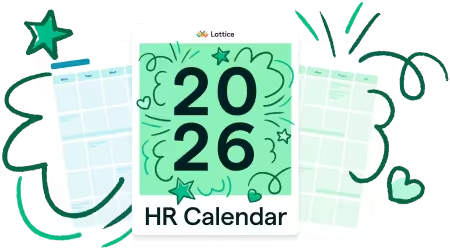Employee Performance Management Policy Template


Download this template for free
By submitting your information, you agree to Lattice's Terms of Service and Privacy Policy. You can opt out anytime.
Thanks! We'll be in touch soon.
When done well, performance management isn’t just about evaluation. It’s about alignment, coaching, recognition, and shared accountability between employees and their managers. It helps employees stay focused on what matters, gives them feedback they can act on, and provides opportunities for development and career growth. It also ensures that leaders can recognize top performers, identify challenges early, and build high-impact teams.
This policy template outlines how to design and implement a thoughtful, equitable, and consistent performance management process — one that helps people do their best work and feel proud of it.
What the Performance Management Policy Should Include
A strong performance management policy provides structure, clarity, and transparency — not just during formal review cycles, but throughout the employee experience. To be most effective, the policy should cover:
- Purpose and scope: Why performance management exists and who it applies to
- Performance expectations: How employee performance is defined and measured
- Feedback cadence: How often performance is reviewed and discussed
- Goal setting: How employees and managers set and track goals
- Formal review process: When reviews happen and what they include
- Growth and development support: How performance ties to learning, mobility, and recognition
- Underperformance management: How low performance is addressed and documented
- Manager and employee responsibilities: What’s expected of both parties throughout the process
- Policy administration: How the process is managed and tracked
Purpose of the Performance Management Policy
The goal of this policy is to create a shared understanding of how performance is evaluated, supported, and recognized across the company. It’s designed to help employees stay aligned with company priorities, feel ownership over their growth, and receive clear, actionable feedback from their managers.
It also ensures that performance conversations happen consistently and fairly, with a clear framework for setting goals, addressing challenges, and celebrating achievements. Ultimately, this policy helps build a workplace where high performance is the norm — and where everyone knows what they need to do to get there.
Sample Employee Performance Management Policy
{{rich-highlight-1}}
Effective Date: [Insert Date]
Policy Owner: People Team / HR Department
Last Reviewed: [Insert Date]
1. Policy Overview
This policy establishes a framework for how employee performance is managed across the organization. The goal of performance management is to support employees in meeting role expectations, growing in their careers, and contributing meaningfully to the company’s goals.
The policy applies to all employees, including full-time and part-time staff, and outlines expectations around feedback, development, formal review cycles, and performance-related decisions.
2. Performance Expectations
Performance is evaluated based on two key dimensions:
- What you do: Achieving individual, team, and organizational goals.
- How you do it: Demonstrating behaviors and values that reflect the company’s culture.
Employees are expected to take ownership of their work, seek and apply feedback, collaborate with their peers, and model professionalism and inclusion in all aspects of their role.
Performance expectations will vary by role but are guided by job descriptions, team goals, and the company’s core values and competencies.
3. Goal Setting
All employees are expected to set clear and measurable goals with their managers. Goals should be aligned with department priorities and overall company strategy, and typically fall into two categories:
- Performance goals: Quantifiable objectives that reflect responsibilities or deliverables.
- Development goals: Areas of personal or professional growth, such as learning new skills or expanding leadership capabilities.
Managers and employees should revisit and adjust goals regularly as priorities shift throughout the year.
4. Feedback and Check-ins
While formal reviews are important, ongoing feedback is critical for performance and development. Managers are encouraged to provide frequent, timely, and constructive feedback in regular 1:1s and project debriefs.
In addition to informal feedback, teams are expected to conduct structured quarterly or biannual check-ins to review progress on goals, identify roadblocks, and discuss development opportunities.
5. Formal Performance Reviews
Employees will participate in a formal performance review at least once per year. The review process includes:
- A self-assessment, where the employee reflects on achievements, challenges, and learnings
- A manager review, evaluating performance against goals and expected behaviors
- Optional peer or cross-functional feedback, depending on role and review cycle structure
Managers will summarize the review discussion in writing, highlighting strengths, growth areas, and next steps. Completed reviews are stored in the HR system and may inform compensation or promotion decisions.
{{rich-highlight-3}}
6. Growth and Development Support
The company is committed to helping employees grow in their careers. Managers should work with employees to:
- Identify learning goals and development priorities
- Recommend internal or external training, mentorship, or stretch projects
- Create Individual Development Plans (IDPs), where appropriate
Employees are encouraged to take initiative in pursuing their growth, with manager support and guidance throughout.
7. Managing Underperformance
If an employee is not meeting expectations, managers should provide timely, specific feedback and document concerns. When appropriate, the company may initiate a Performance Improvement Plan (PIP), which includes:
- Clear performance expectations and measurable goals
- A defined timeline (typically 30–60 days)
- Regular check-ins and documentation of progress
The goal of a PIP is to help the employee improve and succeed. If performance does not improve, employment may be terminated.
8. Manager and Employee Responsibilities
Performance management is a shared responsibility. Employees are expected to:
- Set and track goals
- Communicate openly about progress and challenges
- Actively seek and apply feedback
- Participate fully in the review process
Managers are expected to:
- Set clear expectations and goals
- Provide frequent feedback and coaching
- Conduct timely and thoughtful reviews
- Support employee development and address concerns constructively
9. Policy Administration
The People Team oversees the performance management process and ensures consistency across departments. Performance data is stored securely and used for internal decision-making, including compensation planning, promotion cycles, and talent development initiatives.
Any updates to this policy will be communicated to all employees, and training will be provided for new managers and employees as part of onboarding.
Frequently Asked Questions
1. How often will I receive a formal performance review?
You’ll receive at least one formal review annually. Some teams may also hold mid-year or quarterly check-ins to provide additional feedback.
2. Will my performance rating impact my compensation or bonus?
Performance is one of several factors considered during compensation reviews, alongside role scope, market benchmarks, and company performance.
3. What happens if I disagree with my review?
You’re encouraged to have an open conversation with your manager. If you’re unable to resolve the concern, you may contact the People Team for support.
4. Can I set my own goals?
Yes — in collaboration with your manager. You’re encouraged to propose meaningful goals that align with your role and development interests.
5. How does feedback from peers factor into my review?
Peer feedback may be used in roles that require cross-functional collaboration. It’s typically anonymous and intended to support growth, not penalize performance.
{{rich-highlight-2}}
🚩 Please note: This sample policy is for informational purposes only and does not constitute legal advice. It is a generic template that may not suit your specific circumstances. When adopting or revising a policy, consult legal counsel to ensure compliance with all applicable laws and regulations.
✨ Disclaimer: This resource was developed with the help of artificial intelligence, though reviewed, edited, and approved by (real) humans.
Frequently Asked Questions

Your people are your business
Ensure both are successful with Lattice.





.webp)